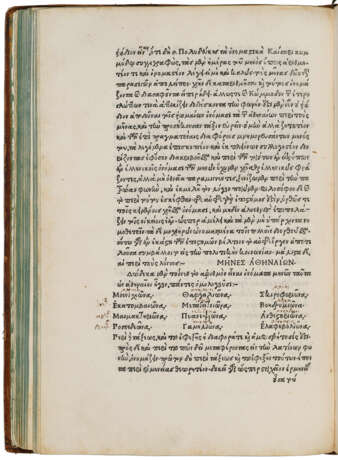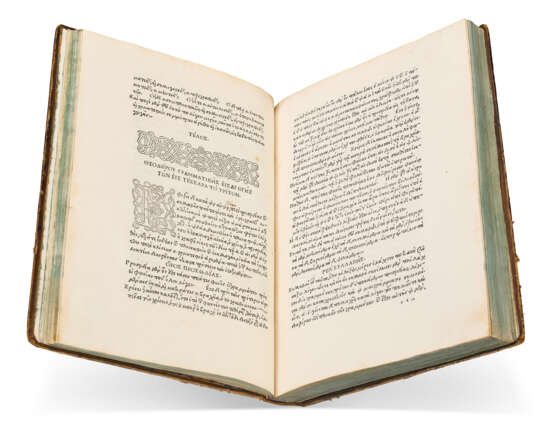ID 1236249
Lot 19 | Theodore Gaza's Grammatica introductiva
Estimate value
$ 20 000 – 40 000
Clumber library copy of the editio princeps of Theodore Gaza's Greek grammar—one of the first works of the Aldine press, a cornerstone of Aldus's printing program and with his own post-press manuscript corrections. The first five years of Aldus's publishing program were dominated by important Greek books and crowned by the magnificent Aristotle (see lot 22). Many of the works printed by him in this period were designed to support its appreciation, including this respected grammar by the Greek grammarian Theodore Gaza. Almost all extant copies of this book bear Aldus's post-press manuscript corrections to the preface and a few other leaves. Due to height discrepancies between the Aldine Greek types and his Latin types, the Greek words within the text of the preface had to be set in an older Jenson type, and in one case the space is simply left blank. Aldus himself filled in the missing Greek word by hand. He has also made a manuscript correction to the Greek quotation from Isocrates at the end of the preface, set in Aldine type but with a ligature mistakenly used in place of mu. Most copies also have a marginal correction on a8v; in this copy, the marginal note has been washed away, but the three dots above the corrected word from Aldus's pen remain.
Written in Greek for students of the ancient language, Gaza's primer provides an immersive course of study in four books of increasing difficulty. One of his major innovations was the reduction of the then-standard 13 verb conjugations to five; "the clarity and simplicity of Gaza's verb scheme is a great pedagogical advantage" (Botley). Aldus here joins that work with the famously obscure treatise of Apollonius Dyscolus and a work erroneously attributed to Apollonius's son Herodianus. This is a finely printed edition in Aldus's first Greek type—and no wonder that it is included among the books in the libraries of Utopia by Thomas More. In his preface to the edition, Aldus praises Gaza's "concinna … brevitate" (elegant brevity) and suggests that while it might difficult on the first read, the second time will be only a delight. Goff G-110; Klebs 438.1; UCLA 5; Bod-inc G-051; BMC V 553; BSB-Ink G-47; GW 10562; Renouard Alde 4:2. See Paul Botley, Learning Greek in Western Europe (2010) for more on the history of the text and Geri Della Rocca de Candal, "Manus Manutii," in Printing and Misprintings (2023) for a discussion of Aldus's post-press annotations.
Super-chancery folio (308 x 211mm). 198 leaves. Types in Greek and Latin. Greek word πάθη added in manuscript to the Latin preface as in other copies, with μέσα in type. Woodcut strapwork initials and ornaments, with uncorrected state of the initial A on h4v (small restorations to blank areas of first leaf, other small marginal repairs throughout; lighting toning, and occasional foxing and stains). 18th-century gilt-stamped calf, edges blue (scuffed at extremities and especially the spine, morocco title labels defective). Provenance: occasional near-contemporary marginal comments and marks in Greek (sometimes washed) – Seventh Duke of Newcastle, Clumber Library (sold 22 November 1937, Sotheby's, lot 54).
| Artist: | Theodorus Gazа (1398 - 1475) |
|---|---|
| Place of origin: | Italy |
| Auction house category: | Antiquarian books, Printed books |
| Artist: | Theodorus Gazа (1398 - 1475) |
|---|---|
| Place of origin: | Italy |
| Auction house category: | Antiquarian books, Printed books |
| Address of auction |
CHRISTIE'S 8 King Street, St. James's SW1Y 6QT London United Kingdom | |
|---|---|---|
| Preview |
| |
| Phone | +44 (0)20 7839 9060 | |
| Buyer Premium | see on Website | |
| Conditions of purchase | Conditions of purchase |




